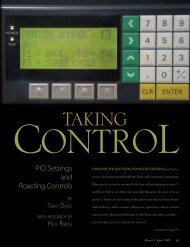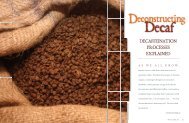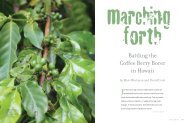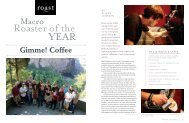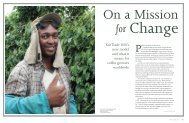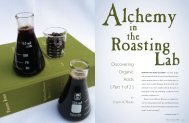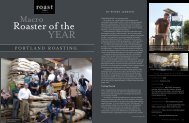a guide to the coffee taster's flavor wheel - Equal Exchange
a guide to the coffee taster's flavor wheel - Equal Exchange
a guide to the coffee taster's flavor wheel - Equal Exchange
Create successful ePaper yourself
Turn your PDF publications into a flip-book with our unique Google optimized e-Paper software.
Piquant<br />
ACIDY<br />
Perceived primarily at <strong>the</strong> tip of<br />
<strong>the</strong> <strong>to</strong>ngue. Created as <strong>the</strong> acids<br />
in <strong>the</strong> <strong>coffee</strong> combine with <strong>the</strong><br />
sugars <strong>to</strong> increase <strong>the</strong> overall<br />
sweetness of <strong>the</strong> brew.<br />
A<br />
Well-Rounded<br />
Nippy<br />
Toward salt<br />
Mild<br />
Delicate<br />
Toward sweet<br />
Toward salt<br />
Toward sweet<br />
Mellow<br />
Acidy<br />
Sweet<br />
a <strong>guide</strong><br />
<strong>to</strong> <strong>the</strong><br />
<strong>coffee</strong><br />
taster’s<br />
<strong>flavor</strong><br />
Palate<br />
by beth ann caspersen<br />
D<br />
o you speak <strong>coffee</strong>?<br />
Learning <strong>to</strong> cup and describe <strong>coffee</strong> is a lifetime endeavor.<br />
Each day I learn something new, and after 15 years in <strong>the</strong> <strong>coffee</strong><br />
industry, I am far from bored—in fact, I find that I am more curious and<br />
hungry for <strong>coffee</strong> knowledge than ever before. The <strong>coffee</strong> industry has evolved<br />
over <strong>the</strong> past few decades—most notably in <strong>the</strong> last decade in education,<br />
MELLOW<br />
Perceived primarily at <strong>the</strong> tip of<br />
<strong>the</strong> <strong>to</strong>ngue. Created as <strong>the</strong> salts<br />
in <strong>the</strong> <strong>coffee</strong> combine with <strong>the</strong><br />
sugars <strong>to</strong> increase <strong>the</strong> overall<br />
sweetness of <strong>the</strong> brew.<br />
<strong>wheel</strong><br />
public learning and access <strong>to</strong> information. Like many of my peers, I was an<br />
apprentice and learned from someone else about <strong>coffee</strong>. There wasn’t any kind<br />
of <strong>coffee</strong> “school” in <strong>the</strong> mid-’90s, but now <strong>the</strong>re is a myriad of information<br />
available about anything related <strong>to</strong> <strong>coffee</strong>, from YouTube videos about <strong>coffee</strong><br />
preparation <strong>to</strong> <strong>coffee</strong> industry events that provide training and insight. The<br />
language of <strong>coffee</strong> encompasses everything from <strong>the</strong> standards for barista<br />
competitions <strong>to</strong> detailed information about how <strong>to</strong> use <strong>the</strong> Specialty Coffee<br />
Association of America (SCAA) cupping form. Never mind <strong>the</strong> inspirational<br />
and innovative work happening with <strong>coffee</strong> production.<br />
Like any o<strong>the</strong>r language, learning <strong>to</strong> speak <strong>coffee</strong> requires education and<br />
practice. One of <strong>the</strong> most interesting, yet taken-for-granted, <strong>to</strong>ols we all have<br />
access <strong>to</strong> is <strong>the</strong> Coffee Taster’s Flavor Wheel. You may be familiar with it and<br />
think you know how it works. So did I. That is, until I started <strong>to</strong> dig in.<br />
continued on page 40<br />
*Definitions from The Coffee Cupper’s Handbook<br />
38 roast May | June 2012 39
A Well-Rounded Palate | A Guide <strong>to</strong> <strong>the</strong> Coffee Taster’s Flavor Wheel (continued)<br />
I started researching <strong>the</strong> origin of this <strong>to</strong>ol over <strong>the</strong> past year<br />
because I will be creating a cross-product sensory training for <strong>coffee</strong><br />
and chocolate liquor, one that will use <strong>the</strong> lessons learned in our world<br />
of specialty <strong>coffee</strong> and provide more structure than is currently being<br />
used in specialty cocoa. So ra<strong>the</strong>r than create a new set of terms, why<br />
not borrow from o<strong>the</strong>r food products? As I started <strong>to</strong> take <strong>the</strong> time <strong>to</strong><br />
think, read and reflect on <strong>the</strong> Coffee Taster’s Flavor Wheel, I realized<br />
I had opened up a can of worms that merited a discussion with <strong>the</strong><br />
wider specialty <strong>coffee</strong> community.<br />
The Flavor Wheel:<br />
A His<strong>to</strong>rical Perspective<br />
The <strong>flavor</strong> <strong>wheel</strong> has enjoyed 15 years in existence. It is used by <strong>the</strong><br />
most seasoned <strong>coffee</strong> cuppers and newbies <strong>to</strong> boot, it employs familiar<br />
and professional vocabulary that is technical but approachable, and it<br />
adorns <strong>the</strong> walls of <strong>coffee</strong> professionals around <strong>the</strong> world. There have<br />
been thousands of copies sold since <strong>the</strong> first printing, and <strong>the</strong> <strong>wheel</strong> is<br />
Coffee taster’s <strong>flavor</strong> <strong>wheel</strong><br />
available in both English and Spanish. The Coffee Taster’s Flavor Wheel<br />
was created in <strong>the</strong> late 1990s for <strong>the</strong> SCAA by Ted Lingle, <strong>the</strong> former<br />
executive direc<strong>to</strong>r of SCAA and current executive direc<strong>to</strong>r of <strong>the</strong> Coffee<br />
Quality Institute.<br />
There are two <strong>coffee</strong> tasting <strong>wheel</strong>s on <strong>the</strong> poster; <strong>the</strong> left side<br />
refers <strong>to</strong> taints and faults, and <strong>the</strong> right side contains distinct aroma<br />
and <strong>flavor</strong> tasting attributes found in <strong>coffee</strong>. Time and again, <strong>the</strong><br />
<strong>flavor</strong> <strong>wheel</strong> has been an invaluable resource for <strong>coffee</strong> professionals;<br />
it’s an easy way <strong>to</strong> provide terms for <strong>flavor</strong>, create confidence for <strong>the</strong><br />
taster and help cuppers jog <strong>the</strong>ir memory when a tasting term is quite<br />
literally on <strong>the</strong> tip of <strong>the</strong> <strong>to</strong>ngue.<br />
I have spent <strong>the</strong> last 10 years training cuppers and working <strong>to</strong><br />
create a common vocabulary with our producer partners. When<br />
explaining <strong>the</strong> <strong>flavor</strong> <strong>wheel</strong>, I spend <strong>the</strong> majority of my time looking<br />
at <strong>the</strong> <strong>wheel</strong> on <strong>the</strong> right side of <strong>the</strong> poster and focusing on <strong>the</strong> more<br />
positive attributes of <strong>coffee</strong>. This right hand <strong>wheel</strong> is divided in<strong>to</strong> two<br />
sections: tastes and aromas. The graphics and terms are easy <strong>to</strong> refer<br />
<strong>to</strong> in a silent room full of cuppers, no matter what level of experience. I<br />
still refer <strong>to</strong> it <strong>to</strong> see if <strong>the</strong> power of suggestion may provide me with an<br />
advanced term not found on <strong>the</strong> colorful poster.<br />
Though <strong>the</strong> <strong>flavor</strong> <strong>wheel</strong> is a great <strong>to</strong>ol, I have always had a<br />
few questions about <strong>the</strong> way it was created, such as why specific<br />
descrip<strong>to</strong>rs like “tea rose” are used, while taste terms like “umami”<br />
are absent. I knew I had <strong>to</strong> start with Lingle <strong>to</strong> gain some his<strong>to</strong>rical<br />
perspective.<br />
Lingle worked with a group of people <strong>to</strong> refine his thinking and<br />
ideas around creating a common vocabulary. This was based on his<br />
own work and his creation of multiple glossaries of words that <strong>the</strong><br />
<strong>coffee</strong> industry was in need of; thus, The Coffee Cupper’s Handbook was<br />
born in 1985. “We needed a more expansive language [for <strong>coffee</strong>],”<br />
he <strong>to</strong>ld me, and The Coffee Cupper’s Handbook worked <strong>to</strong> address this<br />
need. The first version was introduced <strong>to</strong> <strong>the</strong> small group of <strong>coffee</strong><br />
professionals that had organized <strong>the</strong> SCAA. As <strong>the</strong> years passed, <strong>the</strong><br />
SCAA progressed in its thinking and attracted new members and a<br />
deeper understanding of <strong>coffee</strong> <strong>flavor</strong>. It was only after a conversation<br />
with a colleague, Jeff Babcock of Seattle’s Zoka Coffee Roaster & Tea,<br />
that Lingle decided <strong>to</strong> transform The Coffee Cupper’s Handbook in<strong>to</strong> <strong>the</strong><br />
Coffee Taster’s Flavor Wheel poster.<br />
pho<strong>to</strong> courtesy of <strong>Equal</strong> <strong>Exchange</strong><br />
What <strong>coffee</strong> professionals may not know is that <strong>the</strong> <strong>flavor</strong> <strong>wheel</strong><br />
was created as a visual <strong>to</strong>ol <strong>to</strong> accompany The Coffee Cupper’s Handbook.<br />
Through my own work and years of training with producers, cuppers<br />
and clients, I had developed what I thought <strong>to</strong> be a logical way <strong>to</strong><br />
explain <strong>the</strong> <strong>flavor</strong> <strong>wheel</strong>. But when I went back and re-read The Coffee<br />
Cupper’s Handbook I was struck by <strong>the</strong> complexity of it. The <strong>flavor</strong> <strong>wheel</strong><br />
is an important resource that needs acknowledgement as a profound<br />
piece of work in specialty <strong>coffee</strong>. Although <strong>the</strong> scientific appeal found<br />
in The Coffee Cupper’s Handbook may not be <strong>the</strong> easiest <strong>to</strong> understand or <strong>the</strong><br />
most approachable for many people (regarding <strong>the</strong> aroma and <strong>flavor</strong><br />
continued on page 42<br />
40 roast May | June 2012 41
A Well-Rounded Palate (continued)<br />
terms), none<strong>the</strong>less <strong>the</strong> foundation is solid. It may require more<br />
future work <strong>to</strong> make it more accessible <strong>to</strong> everyone.<br />
After learning that <strong>the</strong> two <strong>to</strong>ols were meant <strong>to</strong> work <strong>to</strong>ge<strong>the</strong>r,<br />
I was surprised <strong>to</strong> see that <strong>the</strong>re wasn’t any indication on <strong>the</strong> Coffee<br />
Taster’s Flavor Wheel that one needed <strong>the</strong> handbook <strong>to</strong> interpret<br />
<strong>the</strong> imagery. It seems like <strong>the</strong> relationship between <strong>the</strong>se two<br />
pieces is recommended as opposed <strong>to</strong> vitally dependent on one<br />
ano<strong>the</strong>r.<br />
Faults and Taints Wheel<br />
The left side of <strong>the</strong> poster refers <strong>to</strong> <strong>the</strong> negative effects on <strong>coffee</strong><br />
through five groups—harvesting/drying, s<strong>to</strong>rage/aging, roasting/<br />
caramelization, post-roasting/staling and post-brewing/holding.<br />
Basically anything that has gone wrong with a <strong>coffee</strong> would likely<br />
end up on <strong>the</strong> faults and taints <strong>wheel</strong>. As you may have guessed,<br />
<strong>coffee</strong> cannot remain in a constant state of equilibrium through<br />
each of <strong>the</strong>se stages, and when things go awry, <strong>the</strong> characteristics<br />
are best described through <strong>the</strong> faults and taints <strong>wheel</strong>. Essentially,<br />
this is <strong>the</strong> problem side of <strong>the</strong> Coffee Taster’s Flavor Wheel.<br />
According <strong>to</strong> <strong>the</strong> Coffee Cupper’s Handbook, “If <strong>the</strong> change results in<br />
a minor <strong>flavor</strong> defect, usually limited <strong>to</strong> <strong>the</strong> aromatic properties of<br />
<strong>the</strong> <strong>flavor</strong>, it is referred <strong>to</strong> as a <strong>flavor</strong> taint. Whe<strong>the</strong>r a <strong>flavor</strong> taint<br />
is pleasing or displeasing depends on its type and degree, as well as<br />
<strong>the</strong> cupper’s personal preference. If <strong>the</strong> chemical change results in<br />
a major failing, usually transmitted <strong>to</strong> <strong>the</strong> taste properties of <strong>the</strong><br />
<strong>flavor</strong>, it is referred <strong>to</strong> as a <strong>flavor</strong> fault. Flavor faults are almost always<br />
displeasing, regardless of <strong>the</strong> cupper’s personal preference.”<br />
Aromas<br />
Aroma (o<strong>the</strong>rwise known as fragrance, nose, aftertaste) is <strong>the</strong><br />
general term used <strong>to</strong> encompass all stages of smelling <strong>coffee</strong> on <strong>the</strong><br />
<strong>flavor</strong> <strong>wheel</strong>. The aromas found in <strong>coffee</strong> are experienced through<br />
<strong>the</strong> nasal passage, sending a message <strong>to</strong> <strong>the</strong> olfac<strong>to</strong>ry bulb in <strong>the</strong><br />
brain. The cupper <strong>the</strong>n translates this message in<strong>to</strong> a word like<br />
“fruity.” When you look at <strong>the</strong> aromas on <strong>the</strong> <strong>flavor</strong> <strong>wheel</strong>, you<br />
will find a general category called “enzymatic,” which is linked<br />
<strong>to</strong> <strong>the</strong> “fruity” term. From this point, you have <strong>the</strong> option of two<br />
different fruit categories (“citrus” or “berry-like”) and more terms<br />
<strong>to</strong> describe different fruit options. You look at <strong>the</strong> <strong>wheel</strong>, dig deep<br />
in<strong>to</strong> your memory for <strong>the</strong> aroma you are experiencing, and <strong>the</strong>n<br />
work through <strong>the</strong> possible term <strong>to</strong> match your beliefs. This is how<br />
<strong>the</strong> vast majority of cuppers likely use <strong>the</strong> <strong>flavor</strong> <strong>wheel</strong>.<br />
However, <strong>the</strong> aroma side of <strong>the</strong> <strong>wheel</strong> lists three primary<br />
terms: “enzymatic,” “sugar browning” and “dry distillation.” This<br />
is where I started <strong>to</strong> create a few conflicting arguments. I wondered<br />
if <strong>the</strong> <strong>flavor</strong> <strong>wheel</strong> was created as a way <strong>to</strong> evaluate <strong>coffee</strong> in a<br />
sample cupping or roasted <strong>coffee</strong> in a production cupping. When<br />
cupping samples from our producer partners, we use a light roast<br />
and evaluate <strong>the</strong> cup characteristics with <strong>the</strong> SCAA cupping form.<br />
All of <strong>the</strong> roast colors are <strong>the</strong> same, however we sometimes find<br />
distinctive aromas like maple syrup or cloves.<br />
The Value of Production Cupping<br />
The Coffee Taster’s Flavor Wheel<br />
and The Coffee Cupper’s Handbook can<br />
provide insight in<strong>to</strong> <strong>the</strong> way you<br />
produce <strong>coffee</strong> for your cus<strong>to</strong>mers.<br />
One of <strong>the</strong> most effective <strong>to</strong>ols is a<br />
very basic and old-school method<br />
of analyzing <strong>coffee</strong> roasts through<br />
a process known as production<br />
cupping. At <strong>Equal</strong> <strong>Exchange</strong>, each day<br />
samples from each batch of roasted<br />
<strong>coffee</strong> are brought <strong>to</strong> <strong>the</strong> lab and<br />
cupped <strong>the</strong> following morning. Each<br />
sample lists <strong>the</strong> name of <strong>the</strong> <strong>coffee</strong>,<br />
degree of roast, colorette number<br />
Beth Ann Caspersen at a<br />
production cupping.<br />
(color spectrometer) and <strong>the</strong> number<br />
pho<strong>to</strong> courtesy of <strong>Equal</strong> <strong>Exchange</strong><br />
of <strong>the</strong> roast for that day. Coffees are<br />
organized by origin and in order of roast degree. Companies do this <strong>to</strong><br />
analyze <strong>the</strong> consistency from roast <strong>to</strong> roast of <strong>the</strong> same origin <strong>coffee</strong> (or<br />
blend) and <strong>to</strong> verify/confirm <strong>the</strong> characteristics <strong>the</strong>y want <strong>to</strong> see come out<br />
of a particular <strong>coffee</strong>. Investing in this system requires time, energy and<br />
follow-through, but <strong>the</strong> results can be tremendous.<br />
After each cupping is finished, <strong>the</strong> cuppers (both roasters and qualitycontrol<br />
folks) evaluate each of <strong>the</strong> <strong>coffee</strong>s, talk about what <strong>the</strong>y liked,<br />
what needs <strong>to</strong> change and how <strong>to</strong> make informed changes. Feedback<br />
and production cupping notes may <strong>the</strong>n be sent <strong>to</strong> <strong>the</strong> purchasing,<br />
quality-control and roasting teams each day with <strong>flavor</strong> descriptions and<br />
recommendations.<br />
Production cupping every roast creates a solid feedback loop that<br />
includes everyone in <strong>the</strong> process and builds excitement and shared<br />
responsibility. It’s also a great way <strong>to</strong> encourage various levels of<br />
experimentation. If you are not production cupping in your roastery,<br />
consider it. It’s a solid investment in <strong>the</strong> quality of your <strong>coffee</strong>.<br />
—Beth Ann Caspersen<br />
The Colors<br />
I always thought that <strong>the</strong> colors of <strong>the</strong> <strong>wheel</strong> were attractive and<br />
seemed <strong>to</strong> express <strong>the</strong> terms <strong>the</strong>y surrounded—light yellow for<br />
lemon, dark brown for chocolate—but what I learned from Lingle<br />
was that <strong>the</strong> amount of time and energy put in<strong>to</strong> <strong>the</strong> color scheme<br />
was not a whimsical arrangement related <strong>to</strong> terms, but that each<br />
term was very purposefully put in place <strong>to</strong> represent <strong>the</strong> weight of<br />
<strong>the</strong> molecules that <strong>the</strong>y were meant <strong>to</strong> represent. For example, <strong>the</strong><br />
enzymatic category and <strong>the</strong> terms associated with it actually contain<br />
a lighter molecular weight than those found in <strong>the</strong> dark purple<br />
colors seen in <strong>the</strong> dry distillation category.<br />
In addition <strong>to</strong> <strong>the</strong> significant importance of molecular weight,<br />
<strong>the</strong> aroma categories also have specific definitions that refer <strong>to</strong><br />
<strong>the</strong> way <strong>the</strong> <strong>coffee</strong> was grown, <strong>the</strong> development of sugars in <strong>the</strong><br />
roasting process, and bean fiber. Terms like “<strong>coffee</strong> blossom” in <strong>the</strong><br />
enzymatic category refer <strong>to</strong> <strong>the</strong> development, maturity and terroir<br />
continued on page 44<br />
42 roast May | June 2012 43
A Well-Rounded Palate | A Guide <strong>to</strong> <strong>the</strong> Coffee Taster’s Flavor Wheel (continued)<br />
found in <strong>the</strong> <strong>coffee</strong>, while a term like “maple syrup” in <strong>the</strong> sugar<br />
browning category indicates <strong>the</strong> development of sugars. And, finally,<br />
terms like “clove” from <strong>the</strong> dry distillation directly reflect bean fiber.<br />
Ano<strong>the</strong>r <strong>to</strong>ol that <strong>coffee</strong> professionals have is <strong>the</strong> set of aroma<br />
vials that were developed by Jean Lenoir, <strong>the</strong> famous crea<strong>to</strong>r of wine,<br />
champagne and cigar aroma kits. For <strong>coffee</strong>, Lenoir had specific ideas<br />
about <strong>the</strong> aromatics found in <strong>coffee</strong>, as did Lingle. Upon meeting in<br />
Paris <strong>to</strong> begin working on <strong>the</strong> aroma vial kit, <strong>the</strong>y found that <strong>the</strong>ir<br />
ideas were in alignment. Amazingly enough, with all of <strong>the</strong> possible<br />
aromas you could find in <strong>coffee</strong>, <strong>the</strong>se two professionals were able<br />
<strong>to</strong> settle on a list of 36 terms. Through <strong>the</strong>ir process of exchanging<br />
information, <strong>the</strong>y had <strong>to</strong> change only four terms <strong>to</strong> come <strong>to</strong> an<br />
agreement. Considering <strong>the</strong> wide variety of terms that many cuppers<br />
find outside of <strong>the</strong> aroma section of <strong>the</strong> <strong>flavor</strong> <strong>wheel</strong>, this is very<br />
interesting.<br />
“dearth” of words available in <strong>the</strong> English language <strong>to</strong> describe <strong>flavor</strong>.<br />
In <strong>the</strong> taste category, you don’t find <strong>the</strong> wide-reaching descriptions<br />
that one associates with actual <strong>flavor</strong>s. What was interesting <strong>to</strong> me<br />
was <strong>the</strong> idea that aroma captures many of <strong>the</strong> sentiments we have as<br />
cuppers, but <strong>the</strong> actual <strong>flavor</strong> terms of sweet, sour, salt and bitter seem<br />
<strong>to</strong> be a limiting group.<br />
Imagine a scenario where you identify a <strong>coffee</strong> as being sweet; <strong>the</strong><br />
<strong>flavor</strong> <strong>wheel</strong> provides you with more taste options within <strong>the</strong> sweet<br />
category, and you decide <strong>the</strong> <strong>coffee</strong> <strong>flavor</strong> “mellow” does <strong>the</strong> best job of<br />
capturing your sentiments (see page 38 for a cross-section of this part of<br />
<strong>the</strong> <strong>wheel</strong>). You now have <strong>the</strong> option <strong>to</strong> take “mellow” a step fur<strong>the</strong>r;<br />
you are left with two more options: “mild” and “delicate.” Both tasting<br />
terms are familiar; <strong>the</strong>y seem similar in concept and are widely used.<br />
How are <strong>the</strong>y different? It seems like tasters could proceed at this point<br />
with a judgment call and interpret <strong>the</strong> words in whatever way <strong>the</strong>y<br />
want <strong>to</strong>. But that is not <strong>the</strong> intended use for <strong>the</strong> taste side of <strong>the</strong> <strong>flavor</strong><br />
<strong>wheel</strong>. The vocabulary used refers <strong>to</strong> specific measurements with<br />
adjacent <strong>flavor</strong>s on <strong>the</strong> <strong>wheel</strong> contributing <strong>to</strong> <strong>the</strong> intensity of a specific<br />
<strong>flavor</strong>. Use <strong>the</strong> flow chart breakdown for descriptions, which will help<br />
cuppers justify why one term is better than ano<strong>the</strong>r.<br />
The <strong>flavor</strong>s you experience on <strong>the</strong> cupping table or enjoy in your<br />
brew encompass <strong>the</strong> basic four <strong>flavor</strong>s of sweet, sour, salt and bitter.<br />
Though <strong>the</strong> basic four don’t sound like <strong>the</strong> sexy terms we like <strong>to</strong> use<br />
<strong>to</strong> describe <strong>the</strong> fine attributes in <strong>coffee</strong>, terms like “apricot” or “maple<br />
syrup” are actually aromatics that are described as <strong>flavor</strong>s due <strong>to</strong> <strong>the</strong><br />
open passage between <strong>the</strong> palate and <strong>the</strong> nasal passage that allows us<br />
<strong>to</strong> experience <strong>the</strong>se characteristics retro-nasally; thus, <strong>the</strong>y become<br />
part of our <strong>flavor</strong> description.<br />
The Tastes<br />
You may have learned about four basic tastes through an SCAA class,<br />
<strong>the</strong> Q-grader course or your own background and curiosity about<br />
fundamental <strong>flavor</strong>.<br />
At <strong>the</strong> center-left side of <strong>the</strong> right <strong>flavor</strong> <strong>wheel</strong> you will see <strong>the</strong><br />
term “tastes.” Skirting this word are <strong>the</strong> four basic tastes believed <strong>to</strong><br />
be in <strong>coffee</strong>: sour, sweet, salt and bitter. Lingle pointed out that not<br />
only are <strong>the</strong>re fewer terms on this side of <strong>the</strong> <strong>wheel</strong>, but that <strong>the</strong>re is a<br />
What About Umami?<br />
After attending <strong>the</strong> Applied Sensory and Consumer Science Certificate<br />
Program at <strong>the</strong> University of California, Davis, I was certain that <strong>the</strong><br />
basics of <strong>flavor</strong>s were not fairly represented on <strong>the</strong> <strong>flavor</strong> <strong>wheel</strong>. For<br />
one, an important discovery made about <strong>the</strong> way food products can<br />
taste, dubbed “umami,” was not being represented. I wondered if<br />
<strong>the</strong>re were plans <strong>to</strong> include this fifth taste in a future version of <strong>the</strong><br />
<strong>flavor</strong> <strong>wheel</strong>. However, Lingle has an opposing opinion about umami.<br />
He asserts that <strong>the</strong> <strong>flavor</strong> of umami is a modulated version of salt<br />
introducing fat—basically a merger of salt with water-soluble oil,<br />
much like <strong>the</strong> <strong>flavor</strong> of seaweed and widely known as monosodium<br />
glutamate (MSG). Therefore, he says, it is a subset of salt on <strong>the</strong> Coffee<br />
Taster’s Flavor Wheel.<br />
The Limits<br />
Let’s assume that <strong>the</strong> <strong>flavor</strong> <strong>wheel</strong> is open <strong>to</strong> interpretation and that<br />
it can be used in many different ways. What happens when <strong>the</strong>re is a<br />
descrip<strong>to</strong>r that is not listed on <strong>the</strong> <strong>flavor</strong> <strong>wheel</strong>? (I am certain that ume<br />
pho<strong>to</strong> courtesy of <strong>Equal</strong> <strong>Exchange</strong><br />
plums are not on it.) The <strong>flavor</strong> <strong>wheel</strong> has always provided my mind<br />
with freedom and creative license, but upon reading The Coffee Cupper’s<br />
Handbook, I began <strong>to</strong> look at <strong>the</strong> <strong>wheel</strong> through a more restrictive and<br />
less creative lens.<br />
I had never thought of <strong>the</strong> <strong>flavor</strong> <strong>wheel</strong> as a limiting <strong>to</strong>ol, but<br />
ra<strong>the</strong>r a way <strong>to</strong> encourage tasters <strong>to</strong> dig in<strong>to</strong> <strong>the</strong>ir aroma and <strong>flavor</strong><br />
memories and pull out a term that would be interpreted through <strong>the</strong><br />
<strong>coffee</strong> <strong>the</strong>y are tasting. What I learned is that <strong>the</strong> right-hand <strong>wheel</strong>,<br />
<strong>the</strong> one containing tastes and aromas, is believed <strong>to</strong> represent <strong>the</strong><br />
limits in <strong>coffee</strong>. Knowing that green <strong>coffee</strong> contains more than 200<br />
chemical compounds before it is roasted and hundreds more after<br />
roasting, shouldn’t <strong>the</strong>re be more than 36 aromas and four basic tastes?<br />
It makes sense that cuppers would venture outside <strong>the</strong> lines of <strong>the</strong><br />
<strong>flavor</strong> <strong>wheel</strong> when encountering a particular aroma memory, which is<br />
based on experience and access <strong>to</strong> <strong>the</strong> vocabulary presented. However,<br />
<strong>the</strong> <strong>flavor</strong> <strong>wheel</strong> is meant <strong>to</strong> create a common vocabulary. I believe it<br />
continued on page 46<br />
44 roast May | June 2012 45
A Well-Rounded Palate | A Guide <strong>to</strong> <strong>the</strong> Coffee Taster’s Flavor Wheel (continued)<br />
does that, plus it encourages cupper calibration. But does it s<strong>to</strong>p<br />
<strong>the</strong>re?<br />
At this point, <strong>the</strong>re are no plans <strong>to</strong> change or update The<br />
Coffee Cupper’s Handbook or <strong>the</strong> Coffee Taster’s Flavor Wheel. I can<br />
appreciate <strong>the</strong> <strong>wheel</strong> as it has been described and <strong>the</strong> value I find<br />
in using it for my own business and training. However, <strong>the</strong>re<br />
are many interesting discoveries in <strong>the</strong> food industry, and I don’t<br />
think it could hurt <strong>to</strong> review <strong>the</strong> contents, descriptions and work<br />
<strong>to</strong> get more out of it. If at <strong>the</strong> end of <strong>the</strong> investigation we find that<br />
<strong>the</strong> <strong>wheel</strong> will remain <strong>the</strong> same, so be it. But it doesn’t hurt <strong>to</strong><br />
review and make changes as <strong>the</strong>y come about (<strong>the</strong> third edition of<br />
The Coffee Cupper’s Handbook dates back <strong>to</strong> 2001).<br />
O<strong>the</strong>r Flavor Wheels<br />
Beer<br />
Wheel<br />
Wine<br />
Wheel<br />
© American Society<br />
of Brewing Chemists<br />
© Ann C. Noble,<br />
winearoma<strong>wheel</strong>.com<br />
There are many different kinds of <strong>flavor</strong> and aroma <strong>wheel</strong>s in <strong>the</strong><br />
marketplace, including <strong>wheel</strong>s for perfume, beer, cheese and<br />
wine. I had always used <strong>the</strong> Coffee Taster’s Flavor Wheel for pure<br />
vocabulary and relied on <strong>the</strong> rating system of <strong>the</strong> cupping formats<br />
and standards created by <strong>the</strong> SCAA by which <strong>to</strong> grade <strong>coffee</strong>. But<br />
now I am re-learning this vocabulary <strong>to</strong> fur<strong>the</strong>r identify precise<br />
measurements. In doing so and in exploring <strong>the</strong> wide world of<br />
<strong>flavor</strong>, I ventured in<strong>to</strong> some o<strong>the</strong>r delicious food categories <strong>to</strong><br />
explore ways that <strong>the</strong>ir educational and training in sensory would<br />
bring clarity or more experience in<strong>to</strong> <strong>the</strong> <strong>coffee</strong> industry. I also<br />
wanted <strong>to</strong> see what terms may be universal. The <strong>coffee</strong> industry<br />
borrows so much from o<strong>the</strong>r specialty foods. Though we have<br />
carved out our own thinking and stand tall with our creative<br />
descriptions, it never hurts <strong>to</strong> learn more.<br />
Some say it’s cliché <strong>to</strong> compare specialty <strong>coffee</strong> <strong>to</strong> <strong>the</strong> wine<br />
industry, but I have found that this is a simple way <strong>to</strong> engage<br />
<strong>the</strong> consumer. We should be looking <strong>to</strong> o<strong>the</strong>r specialty foods and<br />
learning about ways <strong>to</strong> fur<strong>the</strong>r our own thinking and sharing<br />
information for o<strong>the</strong>r foods industries. In talking about <strong>the</strong> Coffee<br />
Taster’s Flavor Wheel with Lingle, I referenced <strong>the</strong> beer industry<br />
and <strong>the</strong> wide vocabulary around basic mouthfeel terms (which<br />
by <strong>the</strong> way, is not represented through <strong>the</strong> Coffee Taster’s Flavor<br />
Wheel, but is available through The Coffee Cupper’s Handbook) and <strong>the</strong><br />
importance of keeping an open mind. We may have three decades<br />
under our belt as a specialty <strong>coffee</strong> industry, but people have been<br />
making cheese, beer and wine way longer than that. In <strong>the</strong> <strong>coffee</strong><br />
industry, we may have created some formal structures <strong>to</strong> talk<br />
about what we taste, but, in my mind, we are nowhere close <strong>to</strong><br />
finished, so let’s keep on talking and learning.<br />
Comté<br />
Cheese<br />
Wheel<br />
© Comté Cheese<br />
Association<br />
Beth Ann Caspersen is quality control manager for <strong>Equal</strong><br />
<strong>Exchange</strong>, an importing and <strong>coffee</strong>-roasting cooperative in West Bridgewater,<br />
Mass. She is responsible for managing green grading, cupping of all green <strong>coffee</strong><br />
shipments, training cuppers and overseeing quality-control procedures for roasted<br />
<strong>coffee</strong> production and all <strong>Equal</strong> <strong>Exchange</strong> products. Beth Ann is a Q grader and<br />
will complete her apprenticeship <strong>to</strong> become a Q instruc<strong>to</strong>r this spring. E-mail her<br />
at bacaspersen@equalexchange.coop.<br />
46 roast May | June 2012 47



